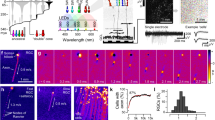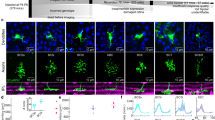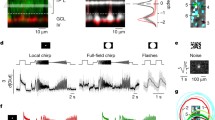Abstract
Both the lamina and the medulla are arrays of parallel neural subunits, each primarily receiving an input from a single retinal sampling element. Every subunit contains several parallel channels capable of monitoring different aspects of the incoming signal while the medulla contains abundant lateral pathways for local and global processing interactions between units. Parallel channels in lamina subunits segregate different components of the receptor input, such as wavelength or polarisation sensitivity. In addition one or more channels sums the majority of receptor inputs to provide a highly sensitive contrast coding pathway, typified by cells LI and L2 in the fly. The sensitivity of the contrast channel is matched to the quality of incoming signals so as to improve the efficiency with which they transmit information to the medulla. Non-linear synaptic amplification ensures that all levels of graded response are fully utilised, while intensity dependant lateral and temporal inhibition reduces the range of signal amplitudes to be coded. Two further lamina channels have been recorded from, but these have not been identified or characterised to the same degree. The medulla is far more complicated than the lamina and its cells are smaller and less accessible to recording. With the exception of movement detection, these technical difficulties are compounded by a lack of hypotheses about the procedures required at this level of processing. However the medulla’s ordered anatomy raises hopes that its exploration may one day bridge the gaps between anatomy and function, and lamina and lobula complex.
Access this chapter
Tax calculation will be finalised at checkout
Purchases are for personal use only
Preview
Unable to display preview. Download preview PDF.
Similar content being viewed by others
References
Arnett, D.W. (1972) Spatial and temporal integration properties of units in first optic ganglion of Dipterans. J. Neurophysiol. 35: 429–444.
Barlow, H.B. (1961) The coding of sensory messages. In: Current Problems in Animal Behaviour. Ed. W.H. Thorpe & O.L. Zangwill. Cambridge, Cambridge University Press, p. 331–360.
Blight, A.R. & Llinas, R. (1980) The non-impulsive stretch receptor complex of the crab: a study of depolarization-release coupling at a tonic sensorimotor synapse. Phil. Trans. R. Soc. Lond. 290B: 219–276.
Bowling, D.B. & Michael, C.R. (1980) Projection patterns of single physiologically characterised optic tract fibres in the cat. Nature (Lond.) 286: 899–902.
Buchner, E. (1976) Elementary movement detectors in an insect visual system. Biol. Cybern. 24: 85–101.
Buchner, E. (1983) Behavioural analysis of spatial vision in insects (This volume).
Campos-Ortega, J.A. & Strausfeld, N.J. (1972) Columns and layers in the second synaptic region of the fly’s visual system: the case for two superimposed neural architectures. In: Information Processing in the Visual Systems of Arthropods. Ed. R. Wehner. Berlin, Springer, p. 31–36.
DeVoe, R.D. (1980) Movement sensitivities of cells in the flyfs medulla. J. Comp. Physiol. 138: 93–119.
DeVoe, R.D. & Ockleford, E.M. (1976) Intracellular responses from cells of the medulla of the fly, Calliphora erythrocephala. Biol. Cybern. 23: 13–24.
Dubs, A. (1982) The spatial integration of signals in the retina and lamina of the fly under different conditions of luminance. J. Comp. Physiol. 146: 321–344.
Dubs, A., Laughlin, S.B. & Srinivasan, M.V. (1981) Single photon signals in fly photoreceptors and first order interneurons at behavioural threshold. J. Physiol. 317: 317–334.
Franceschini, N. (1983) The retinal mosaic of the fly compound eye. (This volume).
Fraser-Rowell, C.H., O’Shea, M. & Williams, J.L.D. (1977) The neuronal basis of a sensory analyser, the acridid movement detector system. IV. The preference for small field stimuli. J. Exp. Biol. 68: 157–188.
French, A.S. & Järvilehto, M. (1978) The transmission of information by first and second order neurons of the fly visual system. J. Comp. Physiol. 126: 87–96.
Glantz, R.M. (1972) Visual adaptation: a case of non-linear summation. Vision Res. 12: 103–109.
Hardie, R.C. (1978) Peripheral Visual Function in the Fly. Ph. D. Thesis. Canberra, Australian National University
Hardie, R.C. (1979) Electrophysiological analysis of fly retina. I. Comparative properties of Rl-6 and R7 and 8. J. Comp. Physiol. 129: 19–33.
Hardie, R.C., Franceschini, N., Ribi, W. & Kirschfeld, K. (1981) Distribution and properties of sex specific photoreceptors in the fly Musca domestica. J. Comp. Physiol. 145: 139–153.
Hausen, K. (1983) The lobula-complex of the fly: Structure, function and significance in visual behaviour (This volume).
Hertel, H. (1980) Chromatic properties of identified neurons in the optic lobe of the bee. J. Comp. Physiol. 137: 215–231.
Honneger, H.-W. (1978) Sustained and transient units in the medulla of the cricket, Gryllus campestris. J. Comp. Physiol. 125: 259–266.
Honneger, H.-W. (1980) Receptive fields of sustained medulla neurons in crickets. J. Comp. Physiol. 136: 191–210.
Howard, J. & Snyder, A.W. (1983) Transduction as a limitation on compound eye function and design. Proc. R. Soc. Lond. B. (In press).
Hughes, A. (1977) The topography of vision in mammals with contrasting life styles — comparative optics and retinal organization. In: Handbook of Sensory Physiology, Vol. VII/5. Ed. F. Crescitelli. Berlin, Springer, p. 614–756.
Hughes, A. (1980) Cat retina and sampling theorem: the relation of transient and sustained brisk-unit cut-off frequency to and cell density. Exp. Brain Res. 40: 250–257.
Järvilehto, M. & Zettler, F. (1971) Localised intracellular potentials from pre- and postsynaptic components in the external plexiform layer of an insect retina. Z. vergl. Physiol. 75: 422–440.
Järvilehto, M. & Zettler, F. (1973) Electrophysiological-histological studies on some functional properties of visual cells and second order neurons of an insect retina. Z. Zellforch. 136: 291–306.
Kien, J. & Menzel, R. (1977a) Chromatic properties of interneurons in the optic lobes of the bee. I. Broad band neurons. 3. Comp. Physiol. 113: 17–34.
Kien, J. & Menzel, R. (1977b) Chromatic properties of interneurons in the optic lobes of the bee. II. Narrow band and colour opponent neurons. J. Comp. Physiol. 113: 35–53.
Kirschfeld, K. (1973) Das neurale Superpositionsauge. Fortschr. Zool. 21: 229–257.
Kirschfeld, K. & Lutz, B. (1974) Lateral inhibition in the compound eye of the fly, Musca. Z. Naturforsch. 29C: 95–97.
Laughlin, S.B. (1973) Neural integration in the first optic neuropile of dragonflies. I. Signal amplification in dark-adapted second order neurons. J. Comp. Physiol. 84: 335–355.
Laughlin, S.B. (1974a) Neural integration in the first optic neuropile of dragonflies. II. Receptor signal interactions in the lamina. J. Comp. Physiol. 92: 357–375.
Laughlin, S.B. (1974b) Neural integration in the first optic neuropile of dragonflies. III. The transfer of angular information. J. Comp. Physiol. 92: 377–396.
Laughlin, S.B. (1974c) Resistance changes associated with the response of insect monopolar neurons. Z. Naturforsch. 29C: 449–450.
Laughlin, S.B. (1976) Neural integration in the first optic neuropile of dragonflies. IV. Interneuron spectral sensitivity and contrast coding. J. Comp. Physiol. 112: 199–211.
Laughlin, S.B. (1981a) Neural principles in the peripheral visual systems of invertebrates. In: Handbook of Sensory Physiology, Vol. VII/6B. Ed. H. Autrum. Berlin, Springer, p. 133–280.
Laughlin, S.B. (1981b) A simple coding procedure enhances a neuron’s information capacity. Z. Naturforsch. 36C: 910–912.
Laughlin, S.B. & Hardie, R.C. (1978) Common strategies for light adaptation in the peripheral visual systems of fly and dragonfly. J. Comp. Physiol. 128: 319–340.
Lilly white, P.G. & Laughlin, S.B. (1979) Transducer noise in a photoreceptor. Nature (Lond.) 277: 560–572.
Lythgoe, J.N. (1979) The Ecology of Vision. Oxford, Clarendon Press.
Martin, A.R. (1955) A further study on the statistical composition of the end-plate potential. J. Physiol. 130: 114–122.
Matic, T. & Laughlin, S.B. (1981) Changes in the intensity-response function of an insect’s photoreceptor due to light adaptation. 3. Comp. Physiol. 145: 169–177.
McCann, G.D. & Arnett, D.W. (1972) Spectral and polarization sensitivity of the Dipteran visual system. J. Gen Physiol. 59: 534–558.
Meinertzhagen, I.A. (1983) The rules of synaptic assembly in the developing insect lamina (This volume).
Meinertzhagen, I.A. & Armett-Kibel, C. (1982) The lamina monopolar cells in the optic lobe of the dragonfly Sympetrum. Phil. Trans. R. Soc. Lond. 297B: 27–49.
Menzel, R. (1974) Spectral sensitivity of monopolar cells in the bee lamina. 3. Comp. Physiol. 93: 337–346.
Menzel, R. & Blakers, M. (1976) Colour receptors in the bee eye- morphology and spectral sensitivity. 3. Comp. Physiol. 108: 11–33.
Menzel, R. & Snyder, A.W. (1974) Polarised light detection in the bee, Apis mellifera. J. Comp. Physiol. 88: 247–270.
Mimura, K. (1976) Some spatial properties in the first ganglion of the fly. J. Comp. Physiol. 105: 64–82.
Nässei, D.R. & Waterman, T.H. (1977) Golgi EM evidence for visual information channeling in the crayfish lamina ganglionaris. Brain Res. 130: 556–563.
Nicol, D. & Meinertzhagen, I.A. (1982) An analysis of the number and composition of the synaptic populations formed by photoreceptors of the fly. 3. Comp. Neurol. 207: 29–44.
Oliver, B.M. (1952) Efficient coding. Bell System Tech. 3. 31: 724–750.
O’Shea, M. & Fraser-Rowell, C.H. (1976) The neuronal basis of a sensory analyser; the acridid movement detector system. II. Response decrement, convergence, and the nature of the excitatory afferents to the fan-like dendrites of the LGMD. J. Exp. Biol. 65: 289–308.
Reichardt, W. (1970) The insect eye as a model for the uptake, transduction and processing of optical data in the nervous system. In: The Neurosciences: Second Study Programme. Ed. F.O. Schmitt. New York, Rockefeller University Press, p. 494–511.
Ribi, W.A. (1981) The first optic ganglion of the bee. IV. Synaptic fine structure and connectivity patterns of receptor cell axons and first order interneurons. Cell Tissue Res. 215: 443–464.
Richards, W.A. (1982) Lightness scale from image intensity distributions. Appl. Optics 21: 2569–2582.
Shannon, C.E. & Weaver, W. (1949) The Mathematical Theory of Communication. Urbana, University of Illinois Press.
Shaw,S.R. (1968) Organization of the locust retina. Symp. Zool. Soc. Lond. 23: 135–163
Shaw,S.R (1975) Retinal resistance barriers and electrical lateral inhibi¬tion. Nature (Lond.) 255: 480–483.
Shaw,S.R. (1979) Signal transmission by slow graded potentials in the arthropod peripherial visual system. In: The Neurosciences: Fourth Study Programme. Ed. F.O. Schmitt. Cambridge, MIT Press, p. 275–295.
Shaw,S.R. (1981) Anatomy and physiology of identified non-spiking cells in the photoreceptor-lamina complex of the compound eye of insects, especially Diptera. In: Neurones Without Impulses. Ed. A. Roberts & B.M.H. Bush. Cambridge, Cambridge University Press, p. 61–116.
Srinivasan, M.V. & Dvorak, D. (1980) Spatial processing of visual information in the movement-detecting pathway of the fly. J. Comp. Physiol. 140: 1–23.
Srinivasan, M.V., Laughlin, S.B. & Dubs, A. (1982) Predictive coding: a fresh view of inhibition in the retina. Proc. R. Soc. Lond. 216B: 427–459
Stavenga, D.G. (1980) Pseudopupils of compound eyes. In: Handbook of Sensory Physiology, Vol. VII/6A. Ed. H. Autrum. Berlin, Springer, p. 357–440.
Strausfeld, N.J. (1983) Functional neuroantomy of the blowfly’s visual system (This volume).
Strausfeld, N.J. & Nässei, D.R. (1981) Neur ©architecture serving compound eyes of crustacea and insects. In: Handbook of Sensory Physiology, Vol. VII/6B. Ed. H. Autrum. Berlin, Springer, p. 1–132.
Wässel, H., Peichl, L. & Boycott, B.B. (1981) Dendritic territories of cat retinal ganglion cells. Nature (Lond.) 292: 344–345.
Wehner, R. (1976) Structure and function of the peripheral visual pathways in Hymenopterans. In: Neural Principles in Vision. Ed. F. Zettler & R. Weiler. Berlin, Springer, p. 280–333.
Zettler, F. & Autrum, H. (1975) Chromatic properties of lateral inhibition in the eye of the fly. J. Comp. Physiol. 97: 181–188.
Zettler, F. & Järvilehto, M. (1971) Decrement-free conduction of graded potentials along the axon of a monopolar neuron. Z. vergl. Physiol. 75: 402–421.
Zettler, F. & Järvilehto, M. (1972) Lateral inhibition in an insect eye. Z. vergl. Physiol. 76: 233–244.
Author information
Authors and Affiliations
Editor information
Editors and Affiliations
Rights and permissions
Copyright information
© 1984 Plenum Press, New York
About this chapter
Cite this chapter
Laughlin, S. (1984). The Roles of Parallel Channels in Early Visual Processing by the Arthropod Compound Eye. In: Ali, M.A. (eds) Photoreception and Vision in Invertebrates. NATO ASI Series, vol 74. Springer, Boston, MA. https://doi.org/10.1007/978-1-4613-2743-1_13
Download citation
DOI: https://doi.org/10.1007/978-1-4613-2743-1_13
Publisher Name: Springer, Boston, MA
Print ISBN: 978-1-4612-9699-7
Online ISBN: 978-1-4613-2743-1
eBook Packages: Springer Book Archive




